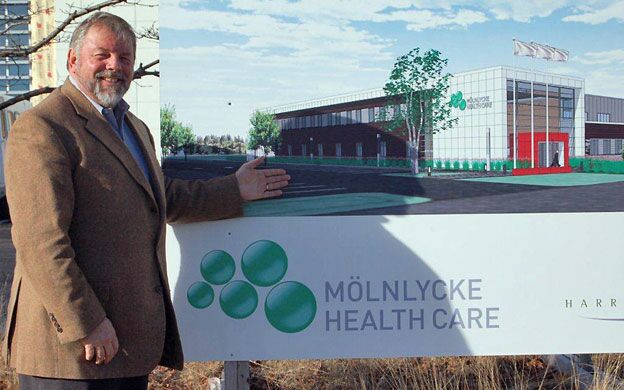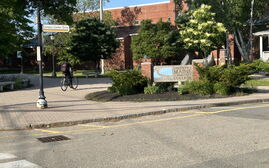MRRA efforts draw national praise
 photo/Courtesy Midcoast Regional Redevelopment Authority
Steve Levesque, executive director of the Midcoast Regional Redevelopment Authority, expects Brunswick Landing's incentives and amenities will attract commercial tenants such as Molnlycke Health Care to the former Navy base. The wound-care company expects to open a $14 million plant in February.
photo/Courtesy Midcoast Regional Redevelopment Authority
Steve Levesque, executive director of the Midcoast Regional Redevelopment Authority, expects Brunswick Landing's incentives and amenities will attract commercial tenants such as Molnlycke Health Care to the former Navy base. The wound-care company expects to open a $14 million plant in February.
Of the 25 major military bases closed by the Base Realignment and Closure Commission in 2005, redevelopment efforts at the former Brunswick Naval Air Station are far and away the most advanced.
That's the assessment of Bryant Monroe, program leader for the Pentagon's Office of Economic Adjustment and point man for the federal government's continuing support of the Midcoast Regional Redevelopment Authority's initiatives to attract businesses and create new jobs at what is now known as Brunswick Landing.
“This round of base closures is particularly tough for a lot of reasons,” says Monroe. “This is taking everyone a lot longer, across the board. For Brunswick to have gone from 'ground zero' — starting with a clean slate of empty buildings and now having 22 tenants at the base — there is no one close to them in that 2005 BRAC portfolio.”
Monroe, who attended MRRA's Nov. 28 annual meeting, has been closely involved in those redevelopment efforts since 2005,when MRRA's predecessor began hosting community meetings to create a master plan that would guide the redevelopment effort.
Whether it's paying for the initial planning grants, or funding the housing study that helped MRRA work out the complicated task of privatizing approximately 700 units of former Navy housing, or simply being a resource, Monroe says the Office of Economic Adjustment is a strategic partner of MRRA. Its financial backing — about $9 million to date — will continue in the implementation phase of redevelopment that has accelerated since the final Navy personnel left on May 31, 2011.
“We viewed Brunswick as one of the most severely impacted communities on the list,” Monroe says.
MRRA Executive Director Steve Levesque, in his 2012 annual report, identifies the following accomplishments:
- 150 employees working at 22 businesses now located at Brunswick Landing, with more than 500 new jobs and $150 million in new investments to be made by those businesses in the next three years.
- Payment by MRRA and its tenants of more than $440,000 in local property taxes to Brunswick. Affordable Midcoast Housing, owned by George Schott, which purchased 700 units of Navy housing in Brunswick and Topsham, is paying nearly $400,000 in taxes to those two towns.
- Mölnlycke Health Care, a Swedish manufacturer of surgical and wound-care products, is nearing completion of a $14.2 million, 79,000-square-foot manufacturing facility. The plant is slated to open in February and initially employ 45 workers.
- More than 100 construction jobs on site.
- Southern Maine Community College opened a campus at Brunswick Landing and now has 400 students enrolled there, with a goal of expanding to 3,000.
- Brunswick Landing was designated in September as a Foreign Trade Zone by the U.S. Department of Commerce, which allows goods from overseas to arrive there duty-free to be processed or incorporated into products sold in U.S. markets or exported again to foreign customers.
University of Southern Maine economist Charles Colgan, a speaker at the MRRA annual meeting, says MRRA's ambitious six-prong redevelopment effort — which markets Brunswick Landing as a center for aviation and aerospace, advanced composites, alternative energy, information technology, education, as well as a resort hotel and conference center — will be challenged by the continued sluggishness of both the national and state economies.
“The Maine economy, frankly, has not recovered at all from the 'great recession' [that began in December 2007],” he says, adding that decisions made by Congress on the expiration of Bush-era tax cuts and anticipated deep federal spending cuts could have a major impact on some of MRRA's initiatives. For example, the production tax credit for wind power is due to expire at the end of 2012. If that happens, he says, new wind power projects aren't likely to be developed, eliminating possibilities for Brunswick Landing in that segment of the alternative energy field.
Perhaps the greatest strength of Brunswick Landing, Colgan says, is the potential it offers for creating a truly “smart growth” neighborhood, with housing, employment, recreation and education opportunities clustered together.
“[Brunswick Landing] is the best place in the state of Maine to model creating livable, walkable, bikable communities with close access to jobs and amenities,” he says. “That will be one of the keys in attracting the 21-to-34-year-old population so essential to the future of Maine.”
While Levesque agrees with Brunswick Landing's smart growth potential, he takes issue with the economist's bleaker assessment of the aviation and aeronautical industry possibilities.
“The aerospace market for repairs and overhaul is growing in the United States right now,” Levesque says. “It's absolutely happening now.”
Levesque agrees with Colgan, though, that having available facilities and a strategic plan alone won't achieve the community's ambitious job creation goals. The work force training opportunities made possible by the SMCC campus and the lower-than-market electricity rates of 9-cents-per-kilowatt hour are other assets he's confident will keep MRRA's momentum going.
He's not alone in that thinking. The Pentagon's Monroe, who's seen dozens of successful base redevelopment efforts across the country, shares that optimism.
“All the right pieces are now in place — they really are — to implement the overall vision this community put together for redeveloping the base,” he says. n













Comments